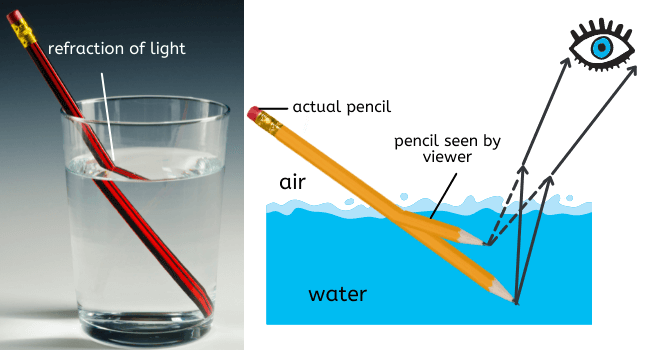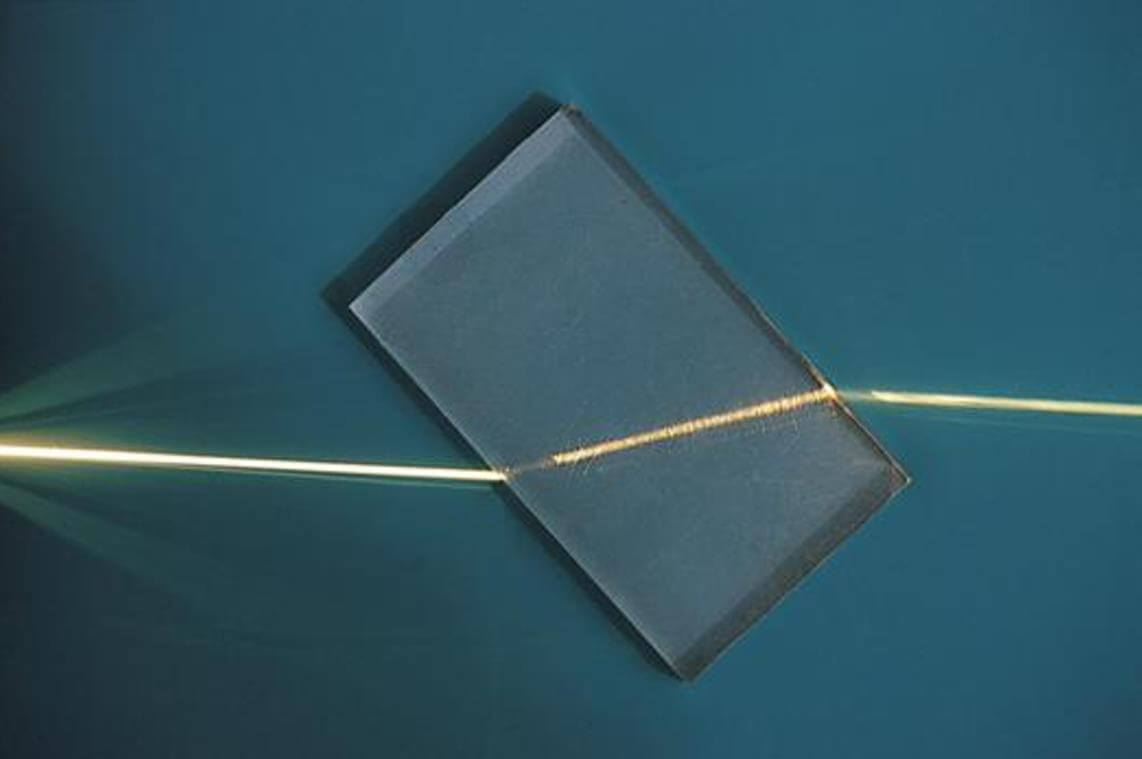Refraction of Light
Subject: Science

Overview
Light refraction refers to the process by which light bends at the interface of two optical mediums. It involves the normal, incident, refracted, and emergent rays. The angle of refraction is always less than the angle of incidence, and the law of refraction states that the angle of refraction is calculated from the angle of incidence. The refractive index of a medium is determined by dividing its speed in air or vacuum by its speed in that medium. Refraction in the water-air interface and in the atmosphere causes stars to appear sparkling, while planets and satellites appear larger due to the shift in their positions.
Following are some light-refraction terms:
- Normal
Normal is the imaginary line perpendicular to two media interfaces. Figure: NN' and N,N,' are normal. - Incident ray
The incident ray is AO from the light source. - Angle of incidence
The incident ray AO's angle with the normal NV is the incidence angle. - Refracted ray
The ray (OR) which bends at the border and enters the second medium, is the refracted ray. - Angle of refraction
The angle (4BON") of refraction is the refracted beam AO's angle with the normal NN'. - Emergent ray
Emergent rays (BC) exit the object into the first medium following refraction. - Emergent angle
Emergence angle (ZCBN,') is the emergent ray BC's angle with the normal N,N,'. - Lateral shift
The lateral shift is the perpendicular distance (CD) between the emergent ray and the refracted line.
In air-glass interference, the angle of refraction (r) is always less than the angle of incidence. As light speeds up in air, rays going via glass-air interference move away from the normal. The angle of incidence (i) and the angle of emergence (e) become equal. Light rays bend towards the normal inside the glass slab and away from it as they exit into the air medium, causing a lateral shift. Light from the air enters any transparent medium at an angle of refraction (r) that depends on the medium and incidence angle. As the angle of incidence changes, so does the angle of refraction. The angle of refraction can be calculated from the angle of incidence using the law of refraction.
Laws of Refraction of Light
Natural light on the glass slab passes through without bending. Increased incidence (i) increases refraction (r). The laws of refraction of light are listed below.
- The incident, normal, and refracted rays all lie on the same plane at the point of incidence when light flows from one optical medium to another.
- The ratio of the sine of the angle of incidence to the sine of the angle of refraction is constant for two media. The constant refractive index of two mediums is μ.
\(\frac{sin i}{sin r}\) = constant μ .............(i)
This law is named Snell's law after the name of the mathematician Willebrord Snellius, who discovered it. When light is transferred from air to glass, the value of the constant μ that is, the ratio of Sin i to Sin r equals the ratio of the airborne light's (c) speed to the glassborne light's (v). The refractive index of light in a given medium is thus determined by dividing its speed in air or vacuum by its speed in that medium.
This means, μ= \(\frac{speed in light in air or vaccume (C)}{speed of light in the medium(V)}\)
The table below lists some media's refractive indices along with the speed of light in each. After examining the refractive indexes of the various media in the table and their corresponding decreasing light speed orders, what conclusions may be drawn?
| Medium | Refractive Index | Speed of Light (m/s) | Medium | Refractive Index | Speed of Light (m/s) |
| Water | 1.33 | 2.25×108 | Glycerin | 1.47 | 2.04×108 |
| Alcohol | 1.36 | 2.19 ×108 | Glass | 1.50 | 2.00×108 |
| Kerosene oil | 1.44 | 2.08×108 | Diamond | 2.42 | 1.24×108 |
Consequences of Refraction of Light
- Consequences of the refraction of light in the water-air interface (from water to air)

The above figures show the bending of an object that is partially dipped in water and the depth of objects in water appearing less than their actual depths.
- Consequences of refraction in the atmosphere

When stargazing, space travel light enters the planet through a series of refractions through various layers of the atmosphere. The refractive indices of the various layers in the atmosphere vary, and the layers' positions are constantly shifting. As a result, light bends in the same direction as well as away from and towards the normal at times. The stars' positions and brightness vary as a result of this. Because of the atmosphere's refraction of light, the stars appear to be sparkling in this fashion. However, because the planets and satellites are closer to Earth and seem larger, the shift in their positions caused by light refraction in the atmosphere is invisible. As such, they are invisible when they twinkle.
Things to remember
- Light refraction is a process where light bends at the interface of two media, causing a lateral shift in the direction of the rays entering the medium.
- The law of refraction states that the incident, normal, and refracted rays all lie on the same plane at the point of incidence when light flows from one optical medium to another.
- The refraction of light at the water-air interface results in objects appearing less deep than their actual depths.
- In the atmosphere, light enters the planet through a series of refractions through various layers, causing light to bend in the same direction and away from and towards the normal at times.
© 2021 Saralmind. All Rights Reserved.





 Login with google
Login with google